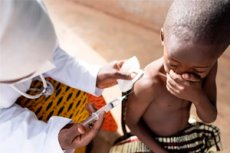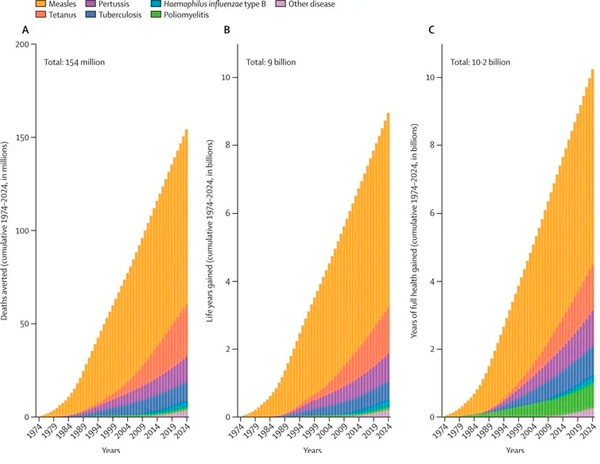50 years of saving lives through vaccination: WHO EPI program has saved 154 million lives
Sist anmeldt: 14.06.2024

Alt iLive-innhold blir gjennomgått med medisin eller faktisk kontrollert for å sikre så mye faktuell nøyaktighet som mulig.
Vi har strenge retningslinjer for innkjøp og kun kobling til anerkjente medieområder, akademiske forskningsinstitusjoner og, når det er mulig, medisinsk peer-evaluerte studier. Merk at tallene i parenteser ([1], [2], etc.) er klikkbare koblinger til disse studiene.
Hvis du føler at noe av innholdet vårt er unøyaktig, utdatert eller ellers tvilsomt, velg det og trykk Ctrl + Enter.

In a recent study published in The Lancet, researchers examined the public health impact of the World Health Organization's Expanded Immunization (EPI) program. The World Health Assembly established the EPI in 1974, a significant step towards expanding the benefits of vaccination for all. The WHO launched the initiative with the initial goal of vaccinating children against measles, polio, smallpox, whooping cough, tetanus, diphtheria and tuberculosis by 1990. The EPI now includes protection against other pathogens for all age groups. The expansion of vaccination programs to cover more diseases has led to a significant increase in protection coverage.
In this study, scientists modeled the impact of EPI on public health. They estimated the number of deaths averted, the number of life years gained by avoiding disability (i.e., disability-adjusted life years), and the number of life years gained by vaccination against 14 pathogens from June 1974 to May 2024 in WHO Member States.
Vaccination for the following pathogens/diseases has been introduced: tuberculosis, yellow fever, Haemophilus influenzae type B, diphtheria, Japanese encephalitis, whooping cough, measles, rotavirus, polio, rubella, invasive pneumococcal disease, tetanus, meningitis A and hepatitis B. A standardized system for assessing exposure to a fully vaccinated person has been developed.
The team synthesized vaccination coverage estimates from the WHO Polio Information System, the Supplementary Immunization Activities Database, the Immunization Dashboard, and the Vaccine Impact Modelling Consortium (VIMC). A total of 24 vaccination events were estimated, categorized by disease, vaccine, dose number, and routine or supplementary immunization. The modeling took three forms. Initially, impact estimates were obtained by simulating published transmission models for polio and measles over a 50-year period. Second, the VIMC transmission models were extended for hepatitis B, rotavirus, rubella, H. Influenzae type B, invasive pneumococcal disease, and Japanese encephalitis from 2000 to 2024. Third, static disease burden models for tuberculosis, pertussis, tetanus, and diphtheria were refined. The three forms of modeling allowed for individual- and population-level effects of vaccination. The primary outcome was to estimate the impact of the EPI on deaths averted, life years gained, years of useful life gained, and the proportion of infant mortality reduction attributable to vaccination. In addition, as secondary outcomes, these interventions were estimated by World Bank income strata and by region.
The researchers estimated that vaccination programs against 14 pathogens averted about 154 million deaths from June 1974 to May 2024; this included 146 million averted deaths among children under five. In addition, 10.2 billion years of useful life gained and nine billion years of life gained during this period. On average, 66 years of useful life gained and 58 years of life gained were gained.

Deaths prevented, years of life saved and years of productive life gained due to vaccination. Data accumulated for 1974–2024. Measles: deaths prevented: 93.7 million; years of life saved: 5.7 billion; gained years of full life: 5.8 billion. Tetanus: deaths prevented: 27.9 million; years of life saved: 1.4 billion; gained years of full life: 1.4 billion. Whooping cough: deaths prevented: 13.2 million; years of life saved: 0.8 billion; gained years of full life: 1 billion. Tuberculosis: deaths prevented: 10.9 million; years of life saved: 0.6 billion; gained years of full life: 0.9 billion. Haemophilus influenzae type B: deaths prevented: 2.8 million; years of life saved: 0.2 billion; gained years of full life: 0.2 billion. Polio: deaths prevented: 1.6 million; years of life saved: 0.1 billion; gained years of full life: 0.8 billion. Other diseases: deaths prevented: 3.8 million; years of life saved: 0.2 billion; gained years of full life: 0.3 billion. It is noticeable that 0.8 billion years of valuable life were gained by preventing cases of polio. Measles vaccination saved 93.7 million lives over 50 years and was one of the most significant life-saving factors across all years in WHO regions and World Bank income strata. In addition, there has been a significant decline in global infant mortality since 1974, with vaccination directly accounting for 40% of this achievement.
Those aged 10, 25 or 50 years in 2024 were estimated to be 44%, 35% or 16% respectively more likely to survive the following year compared to a hypothetical scenario of no vaccinations since 1974. The African and Eastern Mediterranean regions showed the largest absolute increase in lifetime survival probability, while the European region had the smallest. On the other hand, the European and Western Pacific regions had the largest relative increases, while the African region had the smallest.
The results show that vaccines have saved an estimated 154 million lives since 1974, the majority (95%) of which were among children under five. This means nine billion life years saved and 10.2 billion healthy life years gained through vaccination. It is noticeable that measles vaccination was the most significant factor. In addition, vaccination is responsible for almost half of the global decline in infant mortality. Therefore, a child born in 2024 will have a 40% increased chance of survival each year. In addition, the survival benefits of infant vaccination extend beyond age 50. Regions with initially high mortality rates had significant absolute increases, but lower relative increases.
